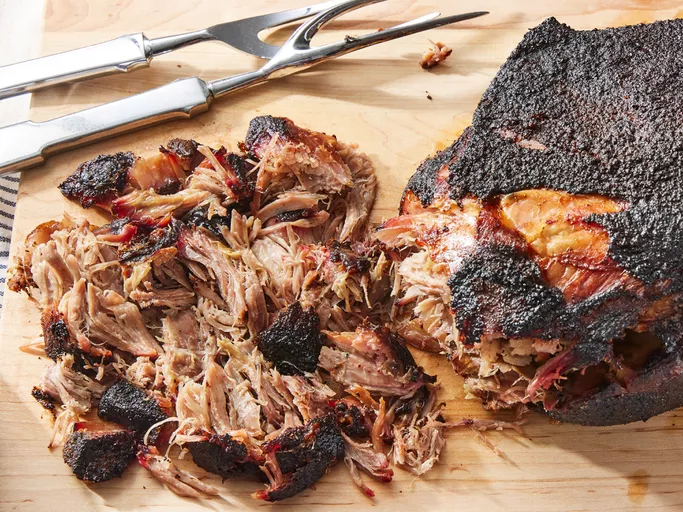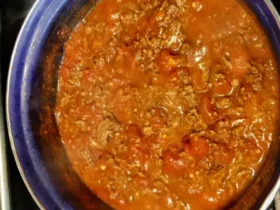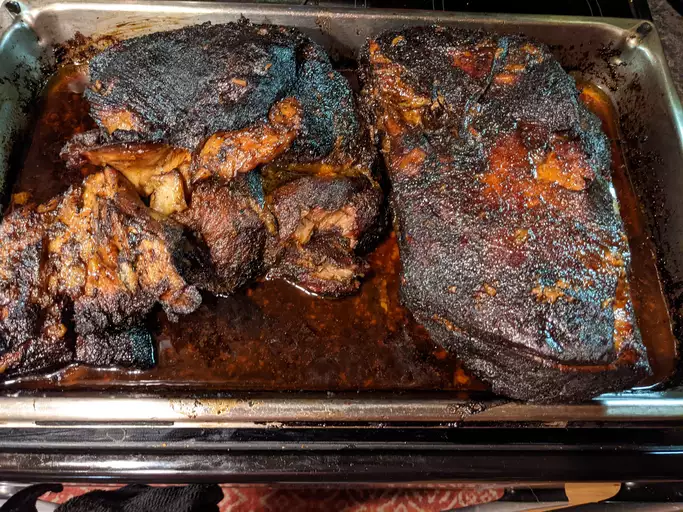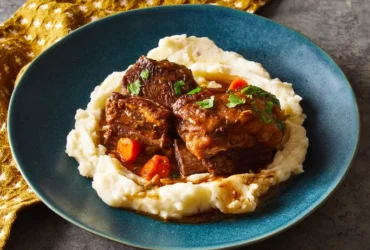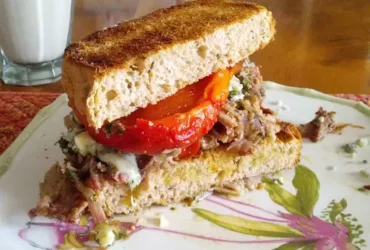Smoking Basics
Selecting a Wood for Smoking
When it comes to smoking meats, the type of wood used can make all the difference in terms of flavor and aroma. Smoking Basics dictate that a good smoke should have a delicate balance of sweet, savory, and umami flavors. To achieve this balance, selecting the right wood for smoking is crucial.
The type of wood to use depends on the type of meat being smoked, as well as personal preference. For Bob’s Pulled Pork recipe, we recommend using woods that complement the rich flavor of pork.
Types of Wood for Smoking
- Hickory: A classic choice for smoking meats, hickory imparts a strong, sweet, and smoky flavor. It’s perfect for bold-flavored meats like pulled pork.
- Mesquite: A strong, earthy wood that adds depth to smoked meats. It’s not recommended for delicate flavors, but pairs well with robust meats like brisket or ribs.
- Apple Wood: A mild and fruity wood that’s perfect for smoking poultry and pork. Its sweetness complements the natural flavor of meat without overpowering it.
- Cherry Wood: Another mild wood that adds a subtle fruitiness to smoked meats. It pairs well with delicate flavors like chicken or fish.
When selecting a wood for smoking, consider the following factors:
- Flavor Profile: Different woods impart distinct flavor profiles. Hickory is strong and smoky, while apple wood is mild and fruity.
- Smoke Intensity: Some woods produce a more intense smoke than others. Mesquite, for example, produces a thick, pungent smoke that’s perfect for robust meats.
- Moisture Content: Wood with high moisture content can lead to a less intense smoke and potentially affect the flavor of your meat.
- Cost: Different types of wood vary in price. Hickory and mesquite are generally more expensive than apple or cherry wood.
To get the best results from your smoker, choose a wood that complements your meat’s natural flavor and provides a balance of sweet, savory, and umami flavors. For Bob’s Pulled Pork recipe, we recommend using hickory or apple wood for a delicious and tender result.
Hickory wood is often used for its strong, sweet flavor.
Smoking Basics are essential for achieving that perfect, tender, and flavorful pulled pork. When it comes to smoking, wood choice plays a crucial role in imparting unique flavors to your meat.
Hickory (wood) is often used for its strong, sweet flavor, but it’s worth noting that other types of wood can also produce excellent results.
Here are some key things to keep in mind when selecting the right (smoking) wood for your pulled pork:
- Hickory is a popular choice due to its robust, sweet flavor profile, which pairs well with pork.
- Other options include Mesquite, Alder, and Cedar, each offering distinct flavor profiles.
- Consider the type of flavor you’re aiming for: strong and sweet (Hickory), mild and fruity (Alder), or earthy and herbal (Mesquite).
- Remember to use only dry, seasoned wood, as green wood can produce off-flavors.
When preparing your smoker for Bob’s Pulled Pork recipe, be sure to:
- Select the right type of smoking wood (e.g., Hickory) based on your desired flavor profile.
- Avoid using too much wood, as this can lead to overpowering flavors and reduced smoke quality.
- Monitor your smoker’s temperature and adjust as needed to ensure optimal cooking conditions for tender, fall-apart pulled pork.
With a little practice and patience, you’ll be able to master the art of smoking and produce delicious, tender pulled pork that’s sure to impress your friends and family!
Oak wood is another popular choice, imparting a smoky flavor without overpowering the pork.
Smoking Basics
In order to appreciate the nuances of smoking for your pulled pork recipe, it’s essential to understand some fundamental principles.
Types of Wood
- Cedar is often used as a starting point due to its distinct aroma and moderate strength. However, other options exist that can better suit your taste preferences.
Oak Wood
- Another popular choice is oak wood, which imparts a smoky flavor without overpowering the pork. Oak’s subtle sweetness complements the richness of the meat.
- The distinct characteristics of oak make it ideal for pulled pork recipes that aim to balance flavors and avoid overwhelming the palate.
Charring vs. Smoldering
- Smokey flavor is often associated with charring, but this method can sometimes result in an overly strong taste.
- A more delicate approach involves smoldering your wood chips or chunks at a lower temperature. This yields a smoother, more refined smokiness that perfectly complements the pulled pork.
Temperature Control
- When smoking, maintaining an optimal temperature range (usually between 225-250°F) is crucial to avoid overcooking or undercooking your pulled pork.
Humidity Levels
- Adequate moisture in the environment helps to keep the meat from drying out during smoking. Typically, you’ll want a relative humidity of around 50-60% for ideal results.
Monitor and Adjust
- Maintain vigilance over your smoker’s temperature, wood consumption rates, and the internal temperature of your meat to guarantee perfect pulled pork every time.
The nuances of smoking for pulled pork require attention to detail and a willingness to experiment. Mastering these fundamental principles will help you unlock unparalleled flavor in your dish.
Pork Preparation and Seasoning
Mixing Your Dry Rub
Pork preparation begins with selecting the right cut of meat for pulled pork. A boneless, skinless Boston butt or picnic ham are ideal options. It’s essential to trim excess fat from the surface of the pork to promote even cooking and prevent flare-ups in the smoker.
Next, mix your dry rub by combining brown sugar, smoked paprika, garlic powder, onion powder, salt, black pepper, cayenne pepper, and any additional seasonings you prefer. The ratio of each ingredient will depend on personal taste, but a general starting point is:
- 2 tablespoons brown sugar
- 1 tablespoon smoked paprika
- 1 teaspoon garlic powder
- 1 teaspoon onion powder
- 2 teaspoons kosher salt
- 1 teaspoon black pepper
- A pinch of cayenne pepper (optional)
Feel free to adjust the proportions to suit your taste preferences. For example, if you prefer a milder flavor, reduce or omit the cayenne pepper.
When mixing your dry rub, ensure that all the ingredients are evenly distributed and well combined. This will prevent any one seasoning from overpowering the others in the finished product.
To apply the dry rub to the pork, place it in a large bowl or container and sprinkle the mixture evenly over both sides of the meat. Gently massage the rub into the surface using your fingertips until the pork is evenly coated. This process should take about 2-3 minutes, depending on the size of your pork.
Let the seasoned pork sit at room temperature for 30 minutes to allow the dry rub to penetrate deeper into the meat. After this initial resting period, place the pork in the smoker and cook according to your preferred temperature and time guidelines.
A combination of salt, brown sugar, smoked paprika, black pepper, and other spices creates a balanced flavor.
Pork preparation is an art form that requires attention to detail and a deep understanding of how different ingredients come together to create a harmonious flavor profile. In the case of Bob’s Pulled Pork recipe, the combination of salt, brown sugar, smoked paprika, black pepper, and other spices creates a balanced flavor that is both tangy and rich.
When it comes to seasoning pork for smoking, there are several key factors to consider. First, you need to understand that pork is a relatively mild-flavored meat, which makes it an ideal canvas for bold and complex seasonings. A good starting point is to use a combination of salt, pepper, and sugar to create a base flavor profile.
Salt serves as the foundation of the seasoning blend, adding depth and umami flavor to the pork. Brown sugar adds a touch of sweetness that balances out the savory flavors of the other ingredients. Smoked paprika brings a smoky, slightly sweet flavor that is perfect for pulled pork.
In addition to these core ingredients, you can also add other spices and seasonings to enhance the flavor of your pulled pork. Some popular options include garlic powder, onion powder, cumin, coriander, and chili powder. When using these ingredients, it’s essential to strike a balance between bold flavors and subtle nuances.
The key to achieving this balance is to taste as you go and adjust the seasoning blend accordingly. You can also experiment with different ratios of salt, sugar, and spices to find the perfect combination for your specific recipe.
When it comes to applying the seasoning blend, there are several options to consider. One approach is to rub the mixture directly onto the pork shoulder or belly before smoking. This allows the flavors to penetrate deep into the meat, resulting in a rich and complex flavor profile.
Alternatively, you can also inject the seasoning blend into the pork using a marinade injector or a syringe. This method allows for more precise control over the amount of seasoning applied, making it ideal for larger quantities of meat.
Once the pork is seasoned, it’s time to smoke it to perfection. Bob’s Pulled Pork recipe involves smoking the pork at 225°F (110°C) for several hours, until it reaches an internal temperature of 190°F (88°C). During this time, the wood chips or chunks added to the smoker impart a rich, smoky flavor that complements the seasoning blend.
The final result is a tender and juicy pulled pork that is both flavorful and aromatic. By combining the right combination of seasonings with proper smoking techniques, you can create a dish that is truly exceptional in every way.
According to Food Safety.gov, proper handling and storage of the pork is crucial for food safety.
Pork preparation and seasoning are crucial steps in creating a delicious and safe pulled pork dish, particularly when using a smoker. According to Food Safety.gov, proper handling and storage of the pork are essential for preventing foodborne illness.
When preparing pork for smoking, it’s vital to handle the meat safely to avoid cross-contamination. Start by washing your hands thoroughly with soap and warm water before and after handling the pork. Make sure to clean and sanitize any utensils, cutting boards, and countertops that come into contact with the meat.
Next, inspect the pork for any visible signs of spoilage or damage. Check for unusual odors, slimy texture, or mold growth. If you notice any of these characteristics, it’s best to discard the pork immediately.
Pork can be stored in the refrigerator at a temperature of 40°F (4°C) or below, but it’s recommended to use it within one to two days. If you plan to store it longer, consider freezing the meat at 0°F (-18°C) or below.
For smoking pork, it’s essential to season the meat properly before cooking. A classic seasoning blend for pulled pork typically includes salt, brown sugar, black pepper, and smoked paprika. You can also add other spices like garlic powder, onion powder, or cayenne pepper to give your dish a unique flavor.
When applying the seasoning blend, make sure to coat all surfaces evenly, including the meat’s crevices and folds. You can use a gentle massage technique to help the seasonings penetrate deeper into the meat.
Before smoking the pork, it’s crucial to preheat your smoker to the correct temperature (usually between 225°F and 250°F). Use wood chips or chunks to create a rich, smoky flavor that complements the seasonings. Monitor the internal temperature of the pork, aiming for an internal temperature of at least 165°F (74°C) to ensure food safety.
Once the pork reaches the desired temperature, let it rest for 10-15 minutes before shredding or chopping it into smaller pieces. This allows the juices to redistribute, making your pulled pork more tender and flavorful.
Finally, be sure to handle and store the cooked pulled pork safely to prevent cross-contamination and foodborne illness. Use a clean utensil to serve the pork, and make sure any leftovers are refrigerated at 40°F (4°C) or below within two hours of cooking.
By following these guidelines for proper handling and storage, seasoning, and smoking techniques, you’ll be able to create a delicious and safe pulled pork dish that your friends and family will love!
The Smoking Process
Maintaining Smoke and Temperature Control
The smoking process involves slowly cooking food over low heat to infuse it with a rich, smoky flavor. In the case of Bob’s Pulled Pork on a Smoker recipe, this means allowing the pork shoulder to cook for several hours, usually between 8-12 hours, depending on the temperature and size of the meat.
During this time, the smoker will produce smoke from wood chips or chunks, which will infuse into the meat. This smoke contains a complex mixture of compounds that provide the characteristic flavor and aroma of smoked foods. The key to maintaining good smoke flavor is to ensure that the smoker produces a steady supply of smoke over the cooking period.
To achieve this, it’s essential to control the temperature within the smoker. A temperature range between 225-250°F (110-120°C) is ideal for slow-cooking pork shoulder. This allows for a gentle heat transfer and helps prevent the meat from drying out. It’s crucial to maintain a consistent temperature throughout the cooking period.
There are several methods to control the temperature, including using a smoker controller or setting up a temperature gauge on the smoker itself. These devices allow you to monitor and adjust the temperature as needed to ensure that it remains within the desired range. Some smokers also come equipped with features like insulation and ventilation systems to help regulate temperature.
Another crucial aspect of maintaining smoke and temperature control is managing airflow in the smoker. This involves adjusting vents or dampers to allow the right amount of air into the smoker while preventing heat loss. A well-regulated airflow ensures that the fire continues to burn steadily, providing a consistent supply of smoke.
The use of wood chips or chunks for smoking also requires careful consideration. Different types of wood impart distinct flavors and aromas, so it’s essential to select the right type for your recipe. For example, hickory is often associated with strong, sweet-smoky flavor, while applewood provides a milder, sweeter taste. Experimenting with different types of wood can help you find the perfect balance of flavors.
Finally, it’s worth noting that maintaining smoke and temperature control is an ongoing process throughout the cooking period. This means regularly checking temperature levels, monitoring airflow, and adjusting as necessary to ensure a consistent outcome. With practice and patience, you’ll develop the skills needed to create perfectly smoked pulled pork with rich, deep flavors.
Keep an eye on the temperature, aiming for 225250°F (110120°C).
The smoking process is a crucial step in achieving tender and flavorful pulled pork, which is essential for Bob’s signature recipe.
To ensure that the meat is cooked evenly and safely, it’s vital to keep an eye on the temperature of the smoker at all times.
Aiming for a temperature range of 225°F to 250°F (110°C to 120°C) will provide the perfect environment for low-and-slow cooking, allowing the pork shoulder to break down and absorb all the delicious flavors from the wood smoke.
When the smoker is at the desired temperature, carefully place the pork shoulder in the smoker, fat side up. This ensures that the fat renders and bastes the meat as it cooks, keeping it juicy and flavorful.
Covering the smoker will help to maintain a consistent temperature and trap the smoke and heat inside, allowing the meat to cook slowly and evenly.
As the pork cooks, it’s essential to monitor its internal temperature regularly. The USDA recommends that the meat reaches an internal temperature of at least 190°F (88°C) for food safety.
Cooking time will vary depending on the size and weight of the pork shoulder, as well as the smoker’s temperature and type of wood used. Generally speaking, it can take anywhere from 8 to 12 hours to cook a large pork shoulder to perfection.
After 4-6 hours, or when the meat is tender enough to shred with a fork, remove it from the heat and wrap it in foil to rest for about 30 minutes. This allows the juices to redistribute throughout the meat, making it even more tender and flavorful.
To enhance the flavor of the pulled pork, Bob recommends adding his signature blend of spices and seasonings before serving. The result is a mouthwatering combination of tangy, sweet, and smoky flavors that will have everyone asking for seconds.
For a precise temperature measurement, consult your smoker’s manual or consider investing in a thermocouple thermometer.
The Smoking Process is an essential step in achieving tender and flavorful pulled pork, as exemplified by Bob’s Pulled Pork on a Smoker Recipe.
The process involves subjecting the meat to a controlled temperature environment for an extended period, which breaks down the connective tissues and infuses it with rich flavors.
For a precise temperature measurement, consult your smoker’s manual or consider investing in a thermocouple thermometer. This will allow you to monitor the internal temperature of the meat and ensure it reaches the optimal range for tenderization and flavor development.
The goal is to maintain a consistent temperature between 225°F (110°C) and 250°F (120°C), allowing for a slow and even cooking process that yields results similar to traditional low-and-slow braising methods.
Once you’ve achieved the desired temperature, it’s time to add your wood chips or chunks to generate the signature smoke flavor. This can be done by placing them in the smoker’s chip tray or directly on the heat source.
The type of wood used for smoking is critical in determining the final flavor profile. Some popular options include hickory, applewood, and mild mesquite.
As you smoke your pulled pork, it’s essential to monitor its internal temperature regularly using a reliable thermometer. This will ensure that the meat reaches the optimal level of tenderness and flavor.
The smoking process can take anywhere from 8-12 hours or even longer, depending on the size of the meat and the desired level of tenderness.
During this time, it’s crucial to maintain a consistent temperature and ensure that the smoker is properly ventilated to prevent the buildup of unwanted flavors or odors.
When you finally remove the pulled pork from the smoker, it should be tender, juicy, and full of rich flavor. Shred or chop it into bite-sized pieces and serve on a bun with your favorite toppings for a delicious and satisfying meal.
- Best Datanyze Alternatives for 2025 - April 24, 2025
- Best Hunter.io Alternatives for 2025 - April 22, 2025
- Best Lead411 Alternatives for 2025 - April 22, 2025

